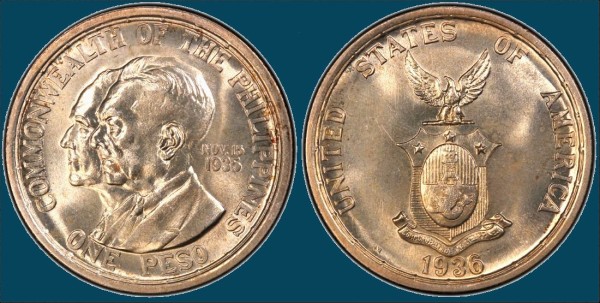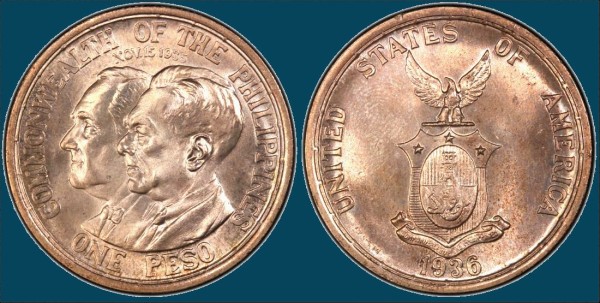To start the New Year off, I'd like to take a trip across the Pacific Ocean to the Philippine Islands to have a look at a three-coin US commemorative set that marked the transition of the Philippines from a US Territory to a US Commonwealth. This set is one of my favorite US commemorative sets!
The US gained possession of the Philippine Islands in 1898 as a result of its victory over Spain in the Spanish-American War. The Filipinos were not looking to exchange one colonial presence (Spain) with another (the US), however, so the first few years under US administration saw a fair amount of violence as the Filipinos rebelled against US oversight - - " the Filipinos even declared their independence in June 1898. Eventually, after more than two years of fighting, agreements were reached and the US began a peaceful administration of the islands that would last until 4 July 1946, the date on which the Philippines became an independent nation.
Read More: Commems CollectionFrom almost the beginning, the US' plan for the Philippine Islands was to support and guide their development to the point at which they could become a self-supporting independent nation. The Philippine Islands under US administration were originally a Territory of the US, which meant a high-level of control of the island's internal and external affairs by the US. To move beyond being a Territory and to achieve the status of Commonwealth, a series of criteria were established. One criterion was to establish an organized and stable currency. The pathway to achieve this was not a simple one due to local economic factors, but enough progress was made by the early 1930s to set the wheels in motion for the transition to Commonwealth status.
The final steps to Commonwealth status (and eventual full independence) for the Philippine Islands began with the enactment of the Tydings-McDuffie Act which was passed by the 73rd US Congress; it was enacted on 24 March 1934. The Act provided a framework for Philippines independence within 10 years. A Constitutional Convention was assembled in the Philippines to draw up the required "Constitution of the Republic of the Philippines." The Constitution was approved by US President Roosevelt in March 1935 and ratified by the people of the Philippines in May. Manuel Quezon was inaugurated as the first President of the Commonwealth on 15 November 1935, following popular elections in September.
One way in which this major milestone on the road to full independence was marked was the issue of a set of three commemorative coins, a pair of One Peso pieces and a single 50 Centavos coin. All three were minted at the US Branch Mint in Manila; the Manila Mint had been striking coins for the Philippines since 1920.
Interestingly, all three featured two portraits of living individuals on their obverse.
- 50 Centavos: Opposing portraits of Manuel Quezon (the first president of the Philippines Commonwealth) and Frank Murphy (the last Governor-General of the Philippines Territory)
- One Peso #1: Conjoined portraits of Manuel Quezon and Frank Murphy
- One Peso #2: Conjoined portraits of Manuel Quezon and US President Franklin D. Roosevelt
The One Peso coin featuring Roosevelt was the second time in the US commemorative series that the current US president was featured on a coin - - " Roosevelt joined Coolidge with the distinction; Coolidge and George Washington were featured on the 1926 coins commemorating the 150th anniversary of US independence.
The reverse of the coins features the Commonwealth's coat-of-arms. The design brings together various elements of Philippines history. The main element is a shield which features three stars at its top; the stars represent the three main island groups of the Philippines (Luzon, Visayas and Mindanao). At the center of the shield is an escutcheon which features a modified version of the coat-of-arms of Manila which was granted to the city in 1596 by the King Philip II of Spain. The castle and mythical sea lion (with sword) are incorporated as symbols of the Philippines' colonial history under Spain. An eagle, representing the US-Philippines connection surmounts the shield. A scroll with the text "Commonwealth of the Philippines" is seen below the shield.
A total of 10,000 of each One Peso coin were minted; 20,000 of the 50 Centavos coin were struck. Three-coin sets were sold for $3.13.
I, along with a good number of other collectors, consider the entire series of US-Philippines coins a specialized subset of
US coinage. They were struck for use within a US Territory/Commonwealth and required the approval of the US Congress. If that doesn't "seal the deal" for you, how about the fact that every coin struck for the Philippines under US administration includes the inscription "United States of America" on their reverse. I definitely consider these part of the US classic commemorative series.
The coins pictured below are all nice, brilliant MS-65 examples with strong luster and minimal marks; they are part of my complete US-Philippines type set.
Enjoy!
1936 Philippines Commonwealth 50 Centavos Commemorative - Murphy & Quezon 1936 Philippines Commonwealth One Peso Commemorative - Murphy & Quezon
1936 Philippines Commonwealth One Peso Commemorative - Murphy & Quezon  1936 Philippines Commonwealth One Peso Commemorative - Roosevelt & Quezon
1936 Philippines Commonwealth One Peso Commemorative - Roosevelt & Quezon  Trivia Note: Among all of the past and current US Territories or Commonwealths, the Philippines is the only one for which we struck specific coins and in which we set up a US Branch Mint.
Trivia Note: Among all of the past and current US Territories or Commonwealths, the Philippines is the only one for which we struck specific coins and in which we set up a US Branch Mint.























